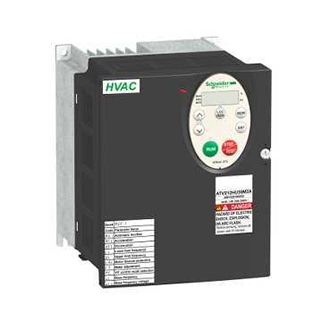Schneider Altivar 212 Drive
The Altivar 212 is avariable speed drive for 3-phase asynchronous motors from 0.75 kW to 75 kW. It is specifically intended for the most commonly encountered fluid management applications in tertiary sector buildings. Due to its eco-energy based design, energy savings of up to 70% can be achieved compared to a traditional control system.
Characteristics:
- Altivar 212 covers motor powers between 0.75 kW and 75 kW on the following supplies:
- 200…240V 3-phase, from 0.75 kW to 30 kW, IP 21
- 380…480V 3-phase, from 0.75 kW to 75 kW, IP 21
- 380…480V 3-phase, from 0.75 kW to 75 kW, UL Type 12/IP 55
- Speed range: 1:50
- Transient overtorque: 110% – 60 s.
- Integrated EMC filters, categories C1 to C3
- Modbus, METASYS N2®, APOGEE FLN P1® and BACnet®.
- Optional: LonWorks Complies to international standards and certifications: UL, CSA, C-Tick and NOM Antiharmonic technology enables a THDI < 30% to be achieved Benefits
Centred on Centralised Technical Management:
- Instant viewing of the energy consumption. Detection of failures for quick intervention: belt breakage, pump running dry, phase failure, supply fault, etc. Preventative maintenance for reducing costs and optimising the equipment: fault alert, operating time, etc. Connection to building supervision network using embedded protocols.
Centred on user-friendliness:
- Tools for installing, parametering and viewing the installation (remote graphic terminal in 6 languages, Multi-Loader, Bluetooth and SoMove Mobile). Compact size. Simple maintenance.
Centred on protection:
- Continuity of service assured. Dedicated “Building” series functions (fire mode, register monitoring, mechanical protection function, etc. Integrated EMC filter, antiharmonic technology (THDI ˜ 30%). Applications
Ventilation:
- Less noise pollution (airdraulic noise, motor noise, etc.). Detection of transmission component breakage. Smoke extraction: forced start with fault inhibition. Automatic restart. Allows register management.
Heating and Air conditioning:
- Optimise control in fluid processing. Use of PID controller (temperature, flow rate, pressure, etc.). Adjustable flow rates for better energy management. Suppression of mechanical resonance.
Pumping:
- Detection of underload/overload, pump running dry. Multi-motor configuration. Limitation of operating time at low speed. Sleep/Wake function. Pressure surge suppression for prolonging the life of the installation.

